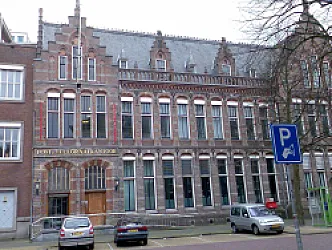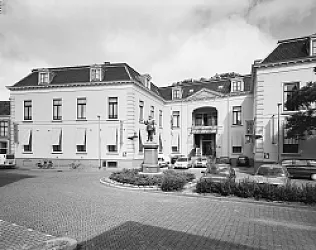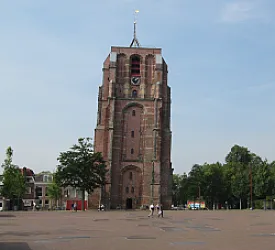Visitez Leeuwarden en 2 jours
6 POIs incontournables, parcours optimisés et anecdotes.
Chargement de la carte...
Vous allez visiter les plus beaux points d'intérêt de Leeuwarden
2 jours à Leeuwarden — Une histoire d'amour de petite ville que vous pouvez goûter en un week-end
Leeuwarden m'a volé le cœur dès que j'ai marché sous ses ponts voûtés. Cette capitale de la Frise ressemble à une chanson secrète que l'on a envie de fredonner pour toujours. Certains la trouvent surfait, mais je l'ai trouvée sincère, animée et étonnamment pleine d'âme. Je l'ai découverte un après-midi pluvieux et suis reparti avec du soleil dans les poches. Si vous prévoyez 2 jours à Leeuwarden, cette introduction est mon encouragement pratique et chaleureux pour tomber amoureux de la ville, vous aussi.
Pourquoi visiter ? Leeuwarden n'est pas que monuments et cartes postales. C'est le tintement de la porcelaine dans un petit café, le doux bourdonnement des vélos et l'écho de l'histoire dans des ruelles étroites. Vous vous tiendrez sous l'Oldehove penché et sentirez le temps basculer. Vous admirerez la façade ornée du Hoofdpostkantoor (Leeuwarden), un plaisir pour les amateurs d'architecture. La dignité silencieuse du Stadhouderlijk Hof murmure la vie de cour. Attendez-vous à des pavés sous les pieds, à l'odeur du pain frais, à des mouettes au-dessus de canaux glacés et à des habitants qui parlent avec une chaleur naturelle. Cette ville offre la curiosité enveloppée de confort.
La planification peut sembler écrasante. Il y a tant à voir que vous pourriez facilement passer des semaines à explorer chaque recoin. Je comprends la pression du temps limité et la culpabilité de laisser des choses de côté. C'est pourquoi ce court et ciblé itinéraire à Leeuwarden existe. Il élimine le superflu et préserve l'essentiel. Ci‑dessous, je vous montre exactement comment passer deux journées complètes, afin que vous ne vous demandiez pas plus tard que voir à Leeuwarden ou que vous ne manquiez l'essentiel lors de votre premier voyage.
Conseil clé : Rendez-vous tôt à l'Oldehove et n'enchaînez pas d'attractions dépendant d'un horaire dès le matin. Les premières heures offrent une lumière plus douce, moins de monde et une perception plus nette de l'échelle des bâtiments. Cela vous donne aussi de la flexibilité lorsque les musées ferment ou que le temps change. Des chaussures confortables comptent plus que le style ici. Maintenant, plongeons dans l'itinéraire pour rendre votre première visite à Leeuwarden à la fois facile et inoubliable.

Petit guide rapide de Leeuwarden
Where to stay:
- Choisissez un hôtel-boutique au bord du canal ou une maison de canal restaurée près de l'Oldehove pour des promenades de 10–15 minutes vers les principaux sites.
- Séjourner près de la gare centrale ou du Hoofdpostkantoor vous place à proximité des bus et des excursions rapides en Frise.
When to visit:
- De la fin du printemps au début de l'automne pour les cafés au bord des canaux, les terrasses et les musées ouverts.
- Visitez pendant les festivals locaux (consultez le calendrier) pour entendre de près la langue frisonne, la musique et la culture des marchés.
Things to do:
- Montez l'Oldehove — la tour penchée et atypique — puis explorez les ruelles médiévales environnantes.
- Visitez le Stadhouderlijk Hof pour voir l'ancienne résidence des stadhouders et ses salons d'époque intimistes.
- Admirez la façade du Hoofdpostkantoor et poussez la porte pour des expositions temporaires, des cafés ou des boutiques de design local.
- Réservez The Walter Case LEEUWARDEN : une visite/jeu de piste interactif — réservez en ligne, ~60–90 min, excellente introduction aux histoires cachées.
Don't forget:
- Goûtez les spécialités frisonnes (sûkerbôle, Fryske dúmkes) et apprenez quelques mots en frison — les locaux l'apprécieront.
- Portez des chaussures confortables pour les pavés ; de nombreux sites sont regroupés et se visitent à pied.
Jour 1 - Leeuwarden
3 POIs à découvrirJour 1 - Matin à Leeuwarden
3 Points d'intérêt - Durée : 2h15 - Distance : 1.1 km - Marche : 0h15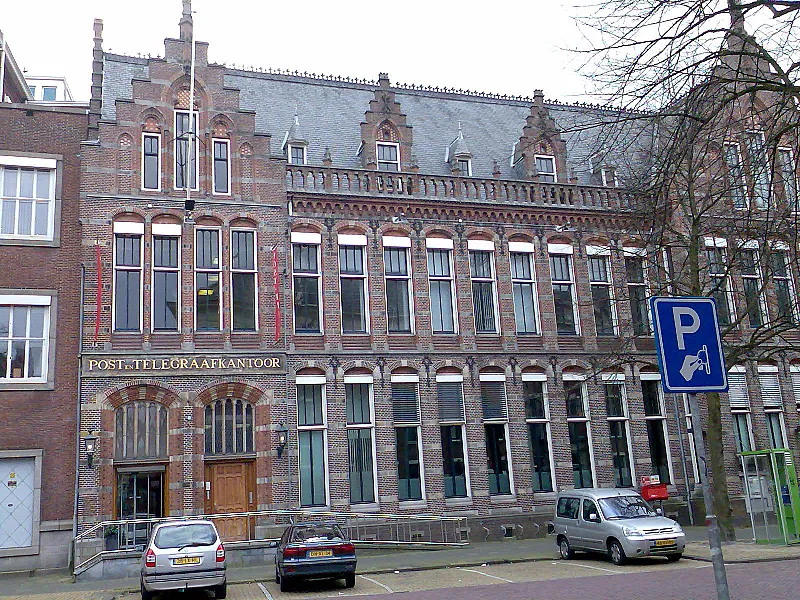
Hoofdpostkantoor (Leeuwarden)
- L'ancien bureau de poste, aujourd'hui classé au patrimoine national, a été transformé en hôtel et en centre de conférences.⌛ La construction du bâtiment a intégré des vestiges de l'ancien monastère franciscain découverts lors de la démolition.
- En avril 1945, le bâtiment a échappé de justesse à la destruction complète après que des explosifs, placés par les occupants allemands, n'aient pas explosé grâce à l'intervention de la résistance locale.
- Le bâtiment, dont la taille a été jugée insuffisante dans les années 1950, a fait l'objet d'agrandissements pour répondre à la demande croissante.
- Le cœur de l'ancienne poste est aujourd'hui un grand café, qui sert des plats inspirés d'une brasserie française et torréfie plus de 5000 grains de café par an, depuis 2015.
- Le Post-Plaza abrite différents espaces, comme le Bodekamer, le Tuinkamer, le Postkamer et le Plugzaal, chacun avec des caractéristiques et des objectifs uniques, parfaits pour les événements et les réunions.
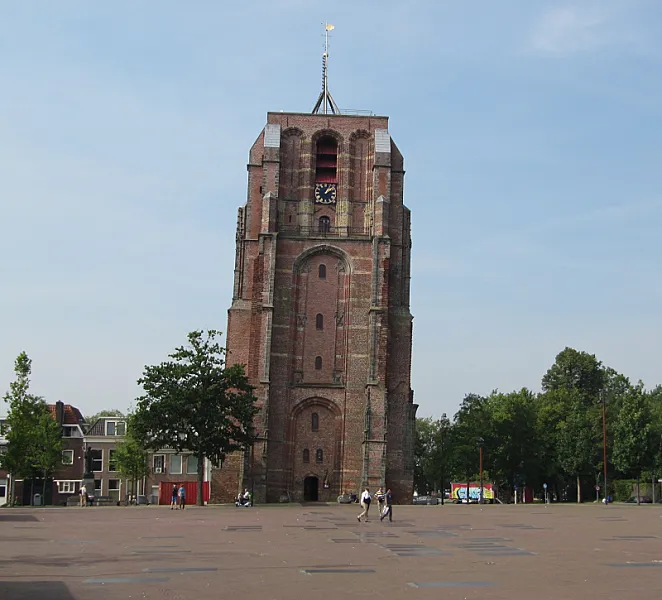
Oldehove (tour)
- L'Oldehove est une tour d'église penchée inachevée dont la construction a débuté en 1529.
- L'inclinaison de la tour a commencé pendant la construction, les tentatives de redressement ont échoué et le projet s'est arrêté en 1532.
- Le clocher abrite deux cloches, l'une coulée en 1633 et l'autre en 1637, pesant 2 100 kg.
- L'église attenante à la tour, construite à l'origine au IXe siècle, a été démolie en 1595-96 mais la tour est toujours debout.
- La tour est principalement faite de briques, avec un peu de grès de Bentheim utilisé dans sa construction.
- La hauteur de la tour est de 39 mètres, comprend 183 marches et est décalée horizontalement de 2 mètres par rapport au centre.
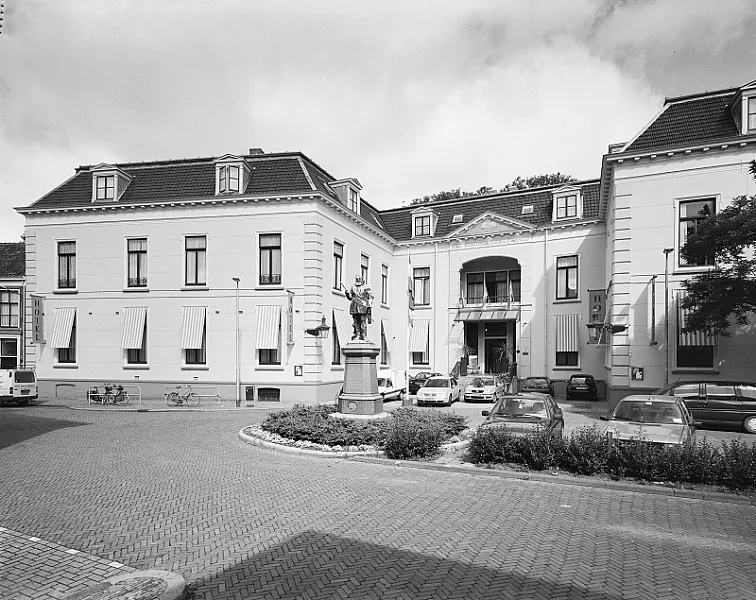
Stadhouderlijk Hof
- Stadhouderlijk Hof était une ancienne résidence de la famille royale néerlandaise et est restée leur propriété jusqu'en 1971.
- Le palais a été initialement construit en 1564 par Boudewijn van Loo, une figure notable au service du roi d'Espagne.
- En 1587, le palais est devenu la résidence de Guillaume Louis, comte de Nassau-Dillenburg, et de son épouse, la comtesse Anna de Nassau.
- Au fil des ans, la propriété du palais est passée entre les mains de différents membres de la famille royale, ce qui explique que plusieurs portraits royaux ornent ses murs.
- William Frederick, prince de Nassau-Dietz, est particulièrement connu pour avoir créé le jardin Prinsentuin, qui existe encore aujourd'hui.
- Depuis 1996, le bâtiment a été transformé en hôtel, préservant autant que possible les décorations et les œuvres d'art du XVIIIe siècle.
Jour 2 - Leeuwarden
3 POIs à découvrirJour 2 - Matin à Leeuwarden
3 Points d'intérêt - Durée : 2h15 - Distance : 1.1 km - Marche : 0h15
Hoofdpostkantoor (Leeuwarden)
- L'ancien bureau de poste, aujourd'hui classé au patrimoine national, a été transformé en hôtel et en centre de conférences.⌛ La construction du bâtiment a intégré des vestiges de l'ancien monastère franciscain découverts lors de la démolition.
- En avril 1945, le bâtiment a échappé de justesse à la destruction complète après que des explosifs, placés par les occupants allemands, n'aient pas explosé grâce à l'intervention de la résistance locale.
- Le bâtiment, dont la taille a été jugée insuffisante dans les années 1950, a fait l'objet d'agrandissements pour répondre à la demande croissante.
- Le cœur de l'ancienne poste est aujourd'hui un grand café, qui sert des plats inspirés d'une brasserie française et torréfie plus de 5000 grains de café par an, depuis 2015.
- Le Post-Plaza abrite différents espaces, comme le Bodekamer, le Tuinkamer, le Postkamer et le Plugzaal, chacun avec des caractéristiques et des objectifs uniques, parfaits pour les événements et les réunions.

Oldehove (tour)
- L'Oldehove est une tour d'église penchée inachevée dont la construction a débuté en 1529.
- L'inclinaison de la tour a commencé pendant la construction, les tentatives de redressement ont échoué et le projet s'est arrêté en 1532.
- Le clocher abrite deux cloches, l'une coulée en 1633 et l'autre en 1637, pesant 2 100 kg.
- L'église attenante à la tour, construite à l'origine au IXe siècle, a été démolie en 1595-96 mais la tour est toujours debout.
- La tour est principalement faite de briques, avec un peu de grès de Bentheim utilisé dans sa construction.
- La hauteur de la tour est de 39 mètres, comprend 183 marches et est décalée horizontalement de 2 mètres par rapport au centre.

Stadhouderlijk Hof
- Stadhouderlijk Hof était une ancienne résidence de la famille royale néerlandaise et est restée leur propriété jusqu'en 1971.
- Le palais a été initialement construit en 1564 par Boudewijn van Loo, une figure notable au service du roi d'Espagne.
- En 1587, le palais est devenu la résidence de Guillaume Louis, comte de Nassau-Dillenburg, et de son épouse, la comtesse Anna de Nassau.
- Au fil des ans, la propriété du palais est passée entre les mains de différents membres de la famille royale, ce qui explique que plusieurs portraits royaux ornent ses murs.
- William Frederick, prince de Nassau-Dietz, est particulièrement connu pour avoir créé le jardin Prinsentuin, qui existe encore aujourd'hui.
- Depuis 1996, le bâtiment a été transformé en hôtel, préservant autant que possible les décorations et les œuvres d'art du XVIIIe siècle.
Où séjourner à Leeuwarden
L'emplacement compte plus ici que les extras sophistiqués : Leeuwarden est compacte et la plupart des sites peuvent se découvrir en deux jours tranquilles, donc choisir un pied-à-terre qui économise du temps de marche ou de vélo étendra vos visites et réduira le stress. Visez à dormir à portée des principaux points d'intérêt pour pouvoir déposer vos bagages, sortir et être à un café, un musée ou un canal en quelques minutes. Pour un court séjour, la proximité vous apporte la lumière du matin sur l'Oldehove et une promenade du soir sans effort le long des façades éclairées près des musées.
La ville s'organise autour d'un centre historique compact bordé de canaux et de rues piétonnes, la gare et le pôle bus se trouvant à une courte distance au sud. Des rues comme Nieuwestad et le secteur autour de l'ancien bureau de poste forment le cœur commercial ; la tour penchée de l'Oldehove se situe un peu à l'écart des rues les plus animées mais reste facilement accessible à pied, et le majestueux Stadhouderlijk Hof ancre le quartier des musées et des jardins. Une fois que vous comprenez que tout rayonne depuis le centre, vous pouvez choisir un emplacement qui vous permette de basculer rapidement d'un site à l'autre.
Si vous voulez être au cœur de l'action, cherchez un hébergement près de l'ancien Hoofdpostkantoor ou le long des principales rues commerçantes : vous serez à quelques minutes des cafés, des galeries et des options nocturnes. Pour un séjour plus calme et plus atmosphérique, choisissez un logement sur une branche de canal ou une rue latérale à l'est de l'Oldehove — vous resterez à courte distance des musées tout en profitant de soirées plus douces. Si les musées et les jardins princiers sont votre priorité, le secteur autour du Stadhouderlijk Hof et de la Prinsentuin constitue une base sereine et cultivée.
Les transports à Leeuwarden sont simples : la gare est à environ 10–15 minutes de marche du centre, les vélos sont nombreux à la location, et les meilleures courtes excursions se font à pied. Taxis et bus locaux sont disponibles mais rarement nécessaires pour le centre ; prévoyez des chaussures confortables et un sac à dos léger pour pouvoir passer sans effort de l'Oldehove au Hof et aux points de vue sur les canaux.
Enfin, privilégiez les conforts pratiques au clinquant : un endroit sûr pour ranger les vélos, un enregistrement flexible si vous arrivez tôt ou tard, et une chambre sur une rue plus calme rendront deux jours détendus. Avec le bon emplacement, vous passerez moins de temps à vous déplacer et plus de temps à savourer le charme compact de Leeuwarden — et c'est justement l'intérêt d'un court séjour.
S'y déplacer à Leeuwarden
Leeuwarden donne l'impression d'être délicieusement petit et accueillant, ce qui rend les transports en commun étonnamment faciles à utiliser même pour un touriste. Le centre-ville est compact, donc beaucoup de visiteurs trouvent que marcher ou faire du vélo permet de rejoindre les points forts comme l'Oldehove, le Stadhouderlijk Hof et le Hoofdpostkantoor plus rapidement que d'attendre une correspondance. Quand il faut prendre un véhicule, le réseau de bus est fréquent et les arrêts sont clairement indiqués ; les services régionaux de train à la gare de Leeuwarden vous relient à la Frise et au-delà. Tout paraît accessible — les conducteurs et les autres passagers acceptent généralement de vous indiquer le bon chemin si vous demandez.
Astuce pratique : prenez une OV-chipkaart si vous prévoyez d'utiliser les transports en commun plus d'une fois. Vous pouvez l'acheter et la recharger aux automates de la gare ou dans de nombreux commerces, et elle fonctionne sur la plupart des bus et trains aux Pays-Bas. Si vous n'avez besoin que d'un trajet, vous pouvez acheter un ticket simple auprès du conducteur ou via les applications des opérateurs, et beaucoup de trains acceptent le paiement sans contact. Pour les courts trajets, pensez à la location d'OV-fiets à la gare de Leeuwarden — c'est un moyen génial et peu coûteux de visiter la ville à deux roues. 🎫
Utilisez Google Maps ou les applications de planification néerlandaises (9292 et les applis Arriva/NS) pour les départs en temps réel et les numéros de quai ; elles vous indiqueront les temps de marche, les numéros de bus et où valider l'entrée ou la sortie. J'ai toujours l'itinéraire sous les yeux en quittant mon logement pour savoir quel arrêt repérer et de quel côté vient le bus. Les mises à jour en direct sont particulièrement utiles en cas de travaux ou de déviation temporaire — l'application vous reconnecte en quelques secondes. 🗺️
Pour économiser, combinez marche et quelques trajets ciblés en bus ou locations de vélo : beaucoup des principales attractions de Leeuwarden sont à 10–15 minutes à pied les unes des autres, ce qui permet d'éviter plusieurs petits trajets payants. Si vous prévoyez plusieurs déplacements en train dans la journée, vérifiez les billets journaliers ou les offres promotionnelles sur les sites NS/Arriva ; sinon recharger l'OV-chipkaart et payer au trajet garde les coûts prévisibles. Évitez aussi d'acheter des forfaits touristiques point à point à moins d'être sûr de les utiliser — le paiement à l'usage est souvent moins cher ici.
Je me souviens de la première fois où nous sommes allés du Hoofdpostkantoor à l'Oldehove : Google Maps nous indiquait une agréable promenade de 12 minutes le long d'un canal, mais j'ai hésité à cause de la pluie. Nous avons opté pour un bus rapide, avons validé notre OV-chipkaart en montant, et en moins de cinq minutes le conducteur nous a fait un signe amical quand je lui ai demandé quel arrêt prendre. Nous sommes descendus, avons suivi un petit panneau vers la tour et y étions avant que les nuages ne se déchirent. Cette petite déviation était totalement sans stress — les transports en commun à Leeuwarden facilitent les explorations spontanées de la ville. 🚇
What to Pack for Leeuwarden
Leeuwarden est compact mais étonnamment riche en ruelles, canaux et façades cachées — vous finirez par marcher plus que prévu. J'y ai fait des escapades de deux jours où j'ai déambulé plus de 10 heures les deux jours; ces petits choix dans mon sac ont rendu le voyage détendu plutôt que précipité. Voici les indispensables que j'utilise réellement et pourquoi chacun m'a fait gagner du temps, du confort ou évité du stress.
1. Chaussures de marche confortables (par ex. Merrell Moab 2 ou Allbirds Wool Runners) : Une fois j'ai marché environ 15 miles sur deux jours à Leeuwarden en poursuivant des tours et des ruelles ; des semelles dures ou des chaussures neuves m'auraient ruiné les pieds. Choisissez des chaussures avec un bon soutien de la voûte plantaire et des semelles adhérentes pour les pavés et les ponts humides — vos pieds sont le moteur de la journée.
2. Vêtements en couches adaptés à la météo + coupe-pluie léger : Le temps néerlandais change vite ; j'ai eu du soleil à 11h00 et de la bruine à 11h20. Une couche de base fine en mérinos, un pull léger et une veste imperméable compacte m'ont tenu à l'aise en admirant des façades ou en attendant près de l'Oldehove. Les couches vous préparent au vent sur les canaux ou à une pause café au soleil.
3. Sac bandoulière (sécurisé, résistant à l'eau) : Je porte un petit sac bandoulière et y ai rangé mon téléphone, ma carte et mon passeport dans les poches intérieures — cela m'a libéré les mains pour les photos et une stroopwafel. Les pickpockets ne sont pas omniprésents, mais pouvoir garder la main sur son sac dans les rues animées ou dans le tram apporte la tranquillité d'esprit et un accès plus rapide aux tickets.
4. Adaptateur secteur européen (Type C/Type F) et câble de téléphone : Les prises néerlandaises sont en 230 V, donc un adaptateur EU compact est indispensable si votre chargeur n'est pas compatible UE. Je l'ai oublié une fois et j'ai dû chercher une boutique tandis que mon téléphone était à 18 % — pas agréable quand cartes et billets sont sur l'écran.
5. Batterie externe (10 000–20 000 mAh) : Entre photos, cartes et vérifications des horaires d'ouverture, mon téléphone se vide vite. Une batterie de 10 000 mAh m'a facilement permis une recharge complète après une journée de plus de 10 heures ; si vous sortez tôt et rentrez tard, optez pour 20 000 mAh pour ne pas courir après une prise dans un café.
6. Optionnel — petit parapluie pliant ou veste de pluie compressible : Je me suis fait surprendre par une averse soudaine près du Waagplein ; un petit parapluie m'a gardé au sec et de bonne humeur. Il est léger, peu encombrant et bien plus utile qu'on ne le croit dans le climat changeant des Pays-Bas.
Profitez de votre voyage à Leeuwarden !
En deux jours, vous suivrez un itinéraire compact et joyeux, rempli du meilleur de Leeuwarden : trois sites incontournables qui montrent son architecture et son histoire. Du grand Hoofdpostkantoor (Leeuwarden) à l'incliné Oldehove en passant par l'élégant Stadhouderlijk Hof, cet itinéraire vous offre tout ce qu'il faut pour goûter au charme, au rythme et à l'histoire de la ville sans vous presser.
Rappelez-vous, ceci est un GUIDE, pas un emploi du temps strict. Restez curieux et flexible : laissez de la place à l'imprévu. La vraie magie survient souvent dans les moments imprévus — se perdre agréablement le long des canaux, s'arrêter dans un café au hasard, ou découvrir par hasard une petite cour. Ne vous mettez pas la pression pour voir TOUT ; savourez quelques lieux en profondeur et laissez les découvertes spontanées devenir les points forts de votre récit à Leeuwarden.
J'espère que vous êtes enthousiaste — je le suis pour vous ! Vous allez adorer flâner autour de l'inclinaison de l'Oldehove, admirer la façade du Hoofdpostkantoor et pénétrer dans l'histoire du Stadhouderlijk Hof. Profitez de chaque instant, parlez aux habitants, prenez des photos qui comptent et collectionnez souvenirs inoubliables. Ces deux jours vous laisseront le sourire aux lèvres et l'envie de revenir.
Vous voulez explorer de façon ludique ? Découvrez la visite gamifiée de Coddy, The Walter Case LEEUWARDEN — elle transforme les monuments en indices et fait de la découverte de Leeuwarden un jeu d'aventure. C'est une façon amusante de rencontrer la ville et de susciter ces découvertes spontanées.
Passez un moment incroyable — prenez votre temps, suivez votre curiosité, et n'hésitez pas à demander si vous avez besoin de conseils. Bon voyage !
Envie de plus d'aventure ?
Découvrez nos jeux d'évasion urbains pour transformer votre visite en aventure interactive !










